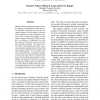314 search results - page 47 / 63 » On Natural Language Processing and Plan Recognition |
92
Voted
FSMNLP
2005
Springer
15 years 5 months ago
2005
Springer
Abstract. Stochastic finite automata are useful for identifying substrings (chunks) within larger units of text. Relevant applications include tokenization, base-NP chunking, name...
NLPRS
2001
Springer
15 years 4 months ago
2001
Springer
in machine translation, long sentences are usually assumed to be difficult to treat. The main reason is the syntactic ambiguity which increases explosively as a sentence become lo...
133
click to vote
CICLING
2006
Springer
15 years 3 months ago
2006
Springer
In this paper, the influence of intonation to recognize dialogue acts from speech is assessed. Assessment is based on an empirical approach: manually tagged data from a spoken-dial...
EMNLP
2010
14 years 9 months ago
2010
Models of latent document semantics such as the mixture of multinomials model and Latent Dirichlet Allocation have received substantial attention for their ability to discover top...
EMNLP
2010
14 years 9 months ago
2010
Many sequence labeling tasks in NLP require solving a cascade of segmentation and tagging subtasks, such as Chinese POS tagging, named entity recognition, and so on. Traditional p...

